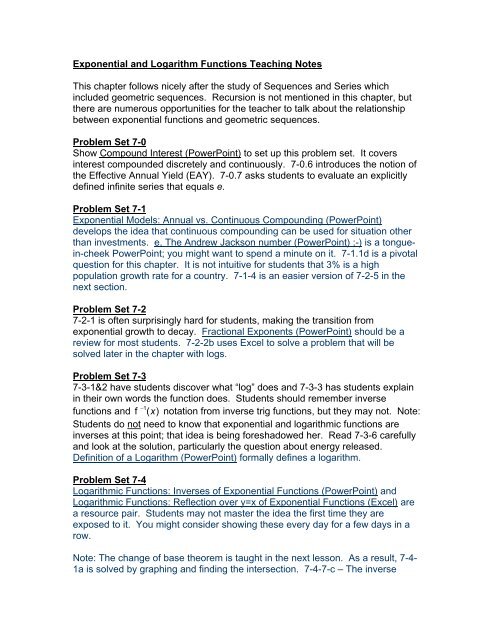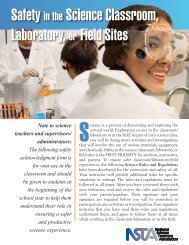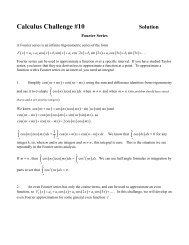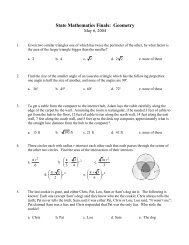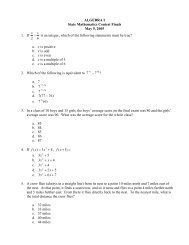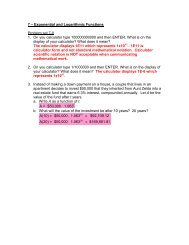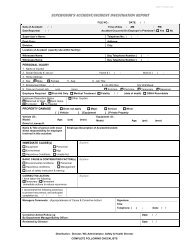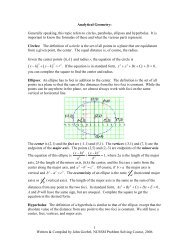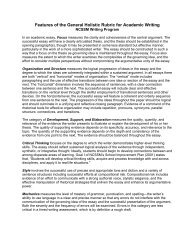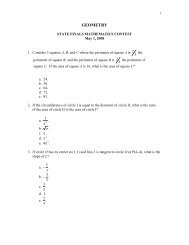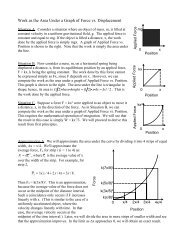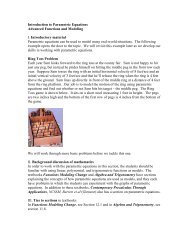Exponential and Logarithm Functions Teaching Notes This chapter ...
Exponential and Logarithm Functions Teaching Notes This chapter ...
Exponential and Logarithm Functions Teaching Notes This chapter ...
You also want an ePaper? Increase the reach of your titles
YUMPU automatically turns print PDFs into web optimized ePapers that Google loves.
<strong>Exponential</strong> <strong>and</strong> <strong>Logarithm</strong> <strong>Functions</strong> <strong>Teaching</strong> <strong>Notes</strong><strong>This</strong> <strong>chapter</strong> follows nicely after the study of Sequences <strong>and</strong> Series whichincluded geometric sequences. Recursion is not mentioned in this <strong>chapter</strong>, butthere are numerous opportunities for the teacher to talk about the relationshipbetween exponential functions <strong>and</strong> geometric sequences.Problem Set 7-0Show Compound Interest (PowerPoint) to set up this problem set. It coversinterest compounded discretely <strong>and</strong> continuously. 7-0.6 introduces the notion ofthe Effective Annual Yield (EAY). 7-0.7 asks students to evaluate an explicitlydefined infinite series that equals e.Problem Set 7-1<strong>Exponential</strong> Models: Annual vs. Continuous Compounding (PowerPoint)develops the idea that continuous compounding can be used for situation otherthan investments. e, The Andrew Jackson number (PowerPoint) ;-) is a tonguein-cheekPowerPoint; you might want to spend a minute on it. 7-1.1d is a pivotalquestion for this <strong>chapter</strong>. It is not intuitive for students that 3% is a highpopulation growth rate for a country. 7-1-4 is an easier version of 7-2-5 in thenext section.Problem Set 7-27-2-1 is often surprisingly hard for students, making the transition fromexponential growth to decay. Fractional Exponents (PowerPoint) should be areview for most students. 7-2-2b uses Excel to solve a problem that will besolved later in the <strong>chapter</strong> with logs.Problem Set 7-37-3-1&2 have students discover what “log” does <strong>and</strong> 7-3-3 has students explainin their own words the function does. Students should remember inverse−1functions <strong>and</strong> f ( x ) notation from inverse trig functions, but they may not. Note:Students do not need to know that exponential <strong>and</strong> logarithmic functions areinverses at this point; that idea is being foreshadowed her. Read 7-3-6 carefully<strong>and</strong> look at the solution, particularly the question about energy released.Definition of a <strong>Logarithm</strong> (PowerPoint) formally defines a logarithm.Problem Set 7-4<strong>Logarithm</strong>ic <strong>Functions</strong>: Inverses of <strong>Exponential</strong> <strong>Functions</strong> (PowerPoint) <strong>and</strong><strong>Logarithm</strong>ic <strong>Functions</strong>: Reflection over y=x of <strong>Exponential</strong> <strong>Functions</strong> (Excel) area resource pair. Students may not master the idea the first time they areexposed to it. You might consider showing these every day for a few days in arow.Note: The change of base theorem is taught in the next lesson. As a result, 7-4-1a is solved by graphing <strong>and</strong> finding the intersection. 7-4-7-c – The inverse
function is graphed by switching the columns for x <strong>and</strong> y from the originalfunction. After the change of base theorem has been introduced in the nextlesson, it is nice to go back to these two problems <strong>and</strong> redo them using thetheorem.
Problem Set 7-5You might want to ask students to do 7-5-1 in class the night before this problemset is assigned. Show it to students <strong>and</strong> give them 1 minute to answer thequestion. Have them do it in their notebooks <strong>and</strong> then reflect on their initialanswer when doing their homework. Converting from <strong>Exponential</strong> to <strong>Logarithm</strong>icEquations (PowerPoint) develops the idea that it is possible to write anexponential equation as an equivalent logarithmic equation. Properties of<strong>Logarithm</strong>s (PowerPoint) is presents the traditional properties of logs with someexamples.Problem Set 7-6<strong>This</strong> section focuses on semi-log graphs. <strong>Logarithm</strong>ic Scales -Part I (avi) <strong>and</strong><strong>Logarithm</strong>ic Scales -Part II (avi) are essential for students to be able to do theproblem set.A great class activity is to go to http://finance.yahoo.com, click on the NASDAQgraph on the left, choose Range = max, <strong>and</strong> toggle back <strong>and</strong> forth between Scale= Linear <strong>and</strong> Log. Notice that a Log scale is the default. Point out the differencebetween what happens in 1973-1974 (read below) with linear vs. log scales.Source: 1973 - 1974 Stock Market, Dustin Woodard,http://mutualfunds.about.com/cs/history/p/crash7.htm, 6/6/07Another long market crash -one that many people still remember (think Vietnam<strong>and</strong> the Watergate sc<strong>and</strong>al). <strong>This</strong> crash lasted for 694 days before bottoming out.7th Worst Stock Market Crash:Date Started: 1/11/1973; Date Ended: 12/06/1974Total Days: 694; Starting DJIA: 1051.70; Ending DJIA: 577.60;Total Loss: -45.1%Problem Set 7-7Curve Fitting with the <strong>Exponential</strong> Function (PowerPoint) sets up the curve fittingproblems in this <strong>and</strong> the next section.Problem Set 7-87-8-2 is a very counterintuitive problem. The answer is about 60-70 million miles,depending on how you start this problem. I suggest measuring the thickness of aream of paper (500 sheets) <strong>and</strong> going from there.Problem Set 7-9<strong>Exponential</strong> cooling (Excel) is a “move the paper” animation to set up the coolingexperiment. I suggest collecting data in class, but data is provided in case youdon’t have time to do so.


